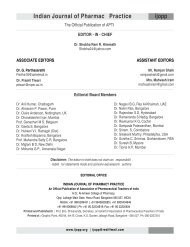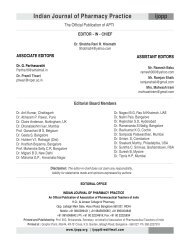APTI ijopp - Indian Journal of Pharmacy Practice
APTI ijopp - Indian Journal of Pharmacy Practice
APTI ijopp - Indian Journal of Pharmacy Practice
- No tags were found...
Create successful ePaper yourself
Turn your PDF publications into a flip-book with our unique Google optimized e-Paper software.
consumed or purchased to obtain the total value for medicines to all their citizens.each item.Developed countries such as New Zealand resorted tod. The values <strong>of</strong> all items is then totaled at the bottom <strong>of</strong> intervention in pharmaceutical management bythe column.highlighting the need for better information to makee. The percentage <strong>of</strong> total value represented by each item effective medicines available without bankrupting theis calculated by dividing the value <strong>of</strong> each item by the health care system (Brougham, 2002). One <strong>of</strong> the firsttotal value <strong>of</strong> all items.steps most developed countries adopted is computerisingf. The list is rearranged to rank the items in descendingthe procurement process and documenting the usage <strong>of</strong>order by percentage <strong>of</strong> total value, starting at the topmedicines. Studies reports the extent to which theirwith the highest value.purchasing and inventory control <strong>of</strong> pharmaceuticalsg. The cumulative percentage <strong>of</strong> total value <strong>of</strong> each itemimproved by initiating computerised inventory control,is calculatedResultswhich progressed into formulary management and otherConcept <strong>of</strong> ABC Analysis was used for Anti-Cancer related interventions in pharmaceutical managementstmedicines procured for the period from 1 October 2006- (Rubin and Keller, 1983; McAllister, 1985). On similarth30 September 2007.The percentage value <strong>of</strong> procured lines BIO has been operating with the computerisedmedicines with the highest, second highest and least inventory for procurement which made it easy to havenumber <strong>of</strong> brand names were tabulated. Docetaxel ready access to the data for ABC Analysis. Based on ABC(18.91%), Gemcitabine (9.37%) and Paclitaxel (8.87%) analysis and decisions taken to promote rational use <strong>of</strong>were in the list <strong>of</strong> percentage value <strong>of</strong> ABC Analysis for medicines, formulary management is in the process <strong>of</strong>medicines with the highest number <strong>of</strong> brand names. Table being initiated at BIO.ABC analysis in conjunction with computerisation is one1 shows the percentage value <strong>of</strong> ABC analysis for<strong>of</strong> the common methods adopted to optimise inventory.medicines with second highest number <strong>of</strong> brand namesThe reason for the majority <strong>of</strong> health institutions toand the least number <strong>of</strong> brands is shown in Table 2.ABC Analysis which was done for the first time in the initiate inventory management techniques is due to theinstitution gave a comprehensive and clear picture <strong>of</strong> recognition <strong>of</strong> raising pharmaceutical budgets and theoverall consumption <strong>of</strong> chemotherapy medicines for a realisation by hospital administrators that reducing theperiod <strong>of</strong> one year. The complete details <strong>of</strong> individual pharmacy budget is an effective method <strong>of</strong> containingconsumption <strong>of</strong> chemotherapy medicines and number <strong>of</strong> institutional costs (Hutchinson et al, 1989).brand names procured for individual medicines were Consequently ABC analysis has become a popularobtained. This helped in making decisions to streamline method <strong>of</strong> quantitative measurement <strong>of</strong> inventory controlthe procurement <strong>of</strong> only three brand names for each (Noel, 1984). Thus, an efficient and productivemedicine that had numerous brands procured earlier. purchasing system results in cost savings (Bair and Lee,Discussion1984) leading to ABC analysis becoming one <strong>of</strong> theThe constant monitoring <strong>of</strong> programs in developed management techniques. Similarly in BIO, PTC decidedcountries helped in identifying increasing pharma- to list only three brand names based on criteria like costceutical expenditures. A Canadian study reports growth and extent to which they are prescribed instead <strong>of</strong><strong>of</strong> pharmaceutical expenditure as being close to double procuring all available brands or brands based onthe rate <strong>of</strong> growth in other health care expenditure clinicians' choices, which is increasing the cost <strong>of</strong>(Willison, 2002). Similarly, a study in Italy reports inventory. It was decided there should also be the optiongrowth <strong>of</strong> 11% per year in the last five years resulting in <strong>of</strong> two more additional brand names in the list and forpharmaceutical expenditure becoming a challenge in the those additional item the clinicians will have to wait tillhealth care system (Rocchi et al, 2004). In response to the medicine is procured.constant increases in pharmaceutical budgets, developed PTCs have been widely accepted both in the developedcountries faced the challenge by introducing various and developing countries as these represent a voluntaryinterventions. It required them to make hard decisions and advisory control strategy with physicians in a centralabout fundamental values in their health care systems position (WHO, 2004). Many PTCs report their activities(Laupacis, 2004). The need to balance benefits <strong>of</strong> and one <strong>of</strong> them reported the important feature requiredmedicines with costs was the prime issue in order to for PTCs to be successful, as “a well-prepared agenda,provide accessibility, equity, and affordability <strong>of</strong> good educational material, active members and strong48
















